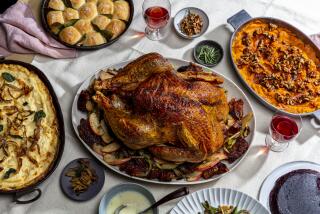Chemicals on the Menu
- Share via
The winter ’89 issue of Priorities, a publication of the American Council on Science and Health in New York, gives a rundown of chemicals inherent in a typical holiday meal.
“How can we ingest so many of these potentially lethal chemicals?” asks Priorities in the article. “The answer is simple,” they write. “Toxicity is dose-related: the smaller the dose, the smaller the effect. Since it is virtually impossible for us to consume any food in the U.S. food supply in amounts that would expose us to toxic levels of natural or man-made chemicals, we need not worry about potential health risks here.”
The council’s scientific adviser, Dr. Alice Ottoboni says: “We survive because we do not take in 100 cups of coffee at one time or 100 pounds of potatoes or 10 pounds of spinach or a fifth of liquor. Our bodies can handle small amounts of natural chemicals. We metabolize them or excrete them unchanged without doing any damage. All living organisms . . . have had to deal with exposure to numerous noxious substances. No animal on earth could survive a day if it were not capable of handling small amounts of a wide variety of foreign chemicals. It is only when we overwhelm the natural defense mechanisms of our bodies by taking in too much at one time or too much too often that we get into trouble.”
See the toxicological summary on Page 49 to review health effects of high-dose exposure to natural chemicals.
“Fortunately, the cornucopia of foods available eliminates the risks of overwhelming our systems with the same foods every day. Be thankful for our superior food supply and Happy Holidays,” the article concludes.
Ready?
Cream of Mushroom Soup: Hydrazines.
Carrots: Carotatoxin, myristicin, isoflavones, nitrate.
Radishes: Glucosinolates, nitrate.
Cherry Tomatoes: Hydrogen peroxide, nitrate, quercetin glycoside, tomatine.
Celery: Nitrate, psoralens.
Roast turkey: Heterocyclic amines, malonadehyde.
Bread Stuffing (with onions, celery, black pepper and mushrooms): Benzo(a)pyrene, disulfides and trisulfides, ethyl carbamate, furan derivatives, dihydrazimes, psoralens, safrole.
Cranberry sauce: Eugenol, furan derivatives.
Lima beans: Cyanogenetic glycosides.
Broccoli spears: Allyl isothiocyanate, glucosinolates, goitrin, nitrate.
Baked potato: amylase inhibitors, arsenic, chaconine, isoflavones, nitrate, oxalic acid, solanine.
Sweet potato: cyanogenetic glycosides, furan derivatives, nitrate.
Rolls: Amylase inhibitors, benzo(a)pyrene, ethyl carbamate, furan derivatives, diacetyl.
Pumpkin pie: myristicin, nitrate, safrole.
Apple pie: acetaldehyde, isoflavones, phlorizin, quercetin glycoside, safrole.
Coffee: benzy(a)pyrene, caffeine, chlorogenic acid, hydrogen peroxide, methylglyoxal, tannins.
Tea: Benzo(a)pyrene, caffeine, quercetin glycosides, tannins.
Red wine: Alcohol, ethyl carbamate, methylglyoxal, tannins, tyramine.
Water: Nitrates.
Assorted nuts: Alflatoxins.
The council is a nonprofit educational organization founded in 1978 to create a forum for debate on issues of health and environment. Its members include physicians and scientists as well as policy advisers from industries such as Anheuser-Busch and Ciba-Geigy Corp. Among council patrons are the Adolph Coors Co., Cooper Industries Foundation, Dow Chemical U.S.A. and General Mills.
More to Read
Sign up for Essential California
The most important California stories and recommendations in your inbox every morning.
You may occasionally receive promotional content from the Los Angeles Times.













